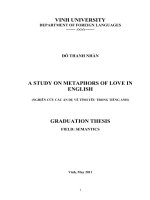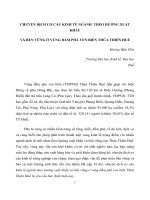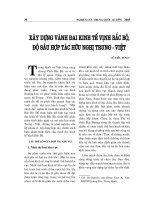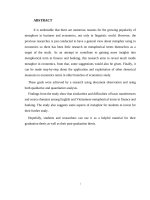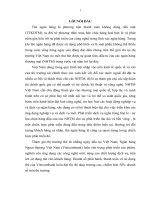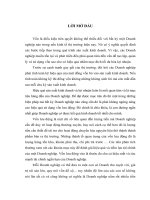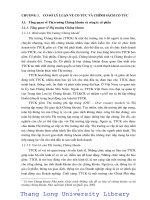NGHIÊN cứu các ẩn dụ TRONG THUẬT NGỮ KINH tế NGÀNH tài CHÍNH NGÂN HÀNG TRONG TIẾNG ANH và TIẾNG VIỆT
Bạn đang xem bản rút gọn của tài liệu. Xem và tải ngay bản đầy đủ của tài liệu tại đây (480.58 KB, 55 trang )
ABSTRACT
It is undeniable that there are numerous reasons for the growing popularity of
metaphors in business and economics, not only in linguistic world. However, the
previous researches is just conducted to have a general view about metaphor using in
economics so there has been little research on metaphorical terms themselves as a
target of the study. As an attempt to contribute to gaining more insights into
metaphorical term in finance and banking, this research aims to reveal much inside
metaphor in economics, from that, some suggestions would also be given. Finally, it
can be made step-by-step about the application and exploitation of other rhetorical
measures in economics terms in other branches of economics study.
These goals were achieved by a research using document observation and using
both qualitative and quantitative analysis.
Findings from the study show that similarities and difficulties of basic transferences
and source domains among English and Vietnamese metaphorical terms in finance and
banking. The study also suggests some aspects of metaphor for students to invest for
their further study.
Hopefully, students and researchers can use it as a helpful material for their
graduation thesis as well as their post-graduation thesis.
i
TABLE OF CONTENT
ABSTRACT i
TABLE OF FIGURES iv
CHAPTER 1 : INTRODUCTION 1
CHAPTER 2: LITERATURE REVIEW 5
CHAPTER 3: METHODOLOGY 13
CHAPTER 4: FINDINGS AND DISCUSSION 16
4.1. Basic transferences of metaphorical terms in finance and banking 16
4.1a. Types of basic transferences 16
4.1a.1. Position 16
4.1a.2. Movement 17
4.1a.3. Shape 17
4.1a.4. Size 17
4.1a.5. Function 18
4.1a.6. Color 18
4.1a.7. Sound 18
4.1a.8. Characteristic 18
4.1b. Frequency 20
4.1c. Dispersion 21
CHAPTER 5: CONCLUSION 42
REFERENCE 46
REFERENCES 48
ii
REFERENCES 49
APPENDIX 50
iii
TABLE OF FIGURES
Picture 1: Domains used in conceptual metaphors 8
Picture 2: Example of domain used in metaphor 9
Chart 1: Basic transferences of English metaphorical
terms in finance and banking 19
Chart 2: Basic transferences of Vietnamese metaphorical
terms in finance and banking 19
Chart 3: Source domains of Vietnamese metaphorical
terms in finance and banking 32
Chart 4: Source domains of English metaphorical terms in
finance and banking 32
Chart 5: Non-equivalent and equivalent Vietnamese-
English and English-Vietnamese metaphorical terms 39
Chart 6: Expression and no expression in non-equivalence
between English-Vietnamese and Vietnamese-English
metaphoric terms 40
Table 1: Basic transferences of Vietnamese metaphorical
terms in finance and banking 18
Table 2: Source domains of English and Vietnamese
metaphorical terms in finance and banking 31
iv
Table 3: Rate of equivalence and non-equivalence between
English-Vietnamese and Vietnamese-English metaphorical
terms in finance and banking 38
Table 4: Expression and no expression in non-equivalence
between English-Vietnamese and Vietnamese-English
metaphoric terms 40
v
vi
CHAPTER 1 : INTRODUCTION
This first chapter will provide the rationale, the aims and objectives, the
organization and significance of the research. In addition, the research questions are
addressed to work as a guideline for the whole research.
1.1. Statement of the problem and the rationale for the study
Metaphor itself has drawn scholars’ attention for more than 2000 years.
Traditionally, scholars regarded it as a matter of language, a linguistic phenomenon
and defined it as a figure of speech in which an implicit comparison is made between
two unlike entities. Thousand years ago, Aristotle gives his definition of metaphor that
“Metaphor consists in giving the thing a name that belongs to something else; the
transference being either from genus to species, or from species to genus, or from
species to species, or on grounds of analogy.” Metaphor is the transference of meaning
from one object to another based on similarities between these two. It is used when the
author wants to hide his real attitude or opinion. Metaphor is a rhetorical device used
in literature; so many people assumed that metaphor belongs to matter of linguistics
for some artistic and rhetorical purpose, not sciences like economics. It is not true. The
truth is that the economy is complex so we have right to use metaphors to make it
understandable.
However, at that time, its study was confined mostly to literature and rhetoric, its
role being primarily decorative.
The followers changed that by approaching the idea of metaphors differently. When
Lakoff’s and Johnson’s theory was introduced, it opened a new horizon for the study
of metaphor. They developed a new theory that has become known as the cognitive
view of metaphor. According to this new perspective, the metaphor is defined as a
cognitive mechanism which the essence of metaphor is understanding and
experiencing one kind of thing in terms of another. Within the theoretical framework
1
of Conceptual Metaphor Theory (Lakoff and Johnson 1980), the metaphor is assigned
more than a purely aesthetic function, as proposed by comparison and substitution
theories; rather, it is supposed to be basic to human cognition, and thus salient in the
way we speak and talk about the world. They argue that metaphors are not just
superfluous, though pleasant rhetorical devices, but an indispensable property of our
thinking and conceptualization (Kövecses, 2005: 14).
After this short introduction to metaphors, the researcher comes to the primary aim
of this paper. Narrowing the scope of metaphor, it is seen that there are different
reasons for the growing popularity of metaphors in business and economics. First of
all, the number of metaphors in economics and business is also connected with their
relation to general language. Ayala (2001) asserts that the language of economics,
being a part of our everyday discourse, is full of metaphors. Thus, metaphors help us
to understand complicated economic concepts.
Besides, to many ESP students and researchers, understanding metaphors in
economics, especially in finance and banking is believed to be challenging.
Understanding this trend, many students and linguistic universities and colleges in
Hanoi have been focusing on this subject for their graduation paper or post-graduation
paper. There have been many researches on the effects of metaphor in economics such
as “A study on metaphors in economics discourse” or under “A study on metaphors in
English and Vietnamese business texts under the topic of securities market”. However,
the previous researches are just conducted to have a general view about metaphor
using in economics so there has been little research on metaphorical terms themselves
as a target of the study.
Therefore, as one attempt to examine this topic, the researcher has decided to
undertake a deep study on metaphors terms in a specific field of economics, especially
for finance and banking in English and Vietnamese as a helpful base for revealing
much inside metaphor in economics.
2
1.2. Aims and objectives of the study
The study aims at investing in factors used in metaphors for financial and banking
terms both in English and Vietnamese. Its main purpose is not only to study metaphor
for the terms under the general view but also to check theory in practical documents, in
other words, establish whether any universal or culture-specific aspects of this
metaphor may be found in the two languages. It is hoped to provide an account of the
use of metaphor as its importance in Business English, particularly in finance and
banking; improve learners’ specialized reading of business texts and help them
produce native-like discourse when they translate business texts.
Therefore, it may be beneficiary for ESP students in both economic and non-
economic universities. Besides, it is expected that the result of this research will also
be useful for economists and people interested in the same subject to learn, and study
further.
In long-term, if the result is positive, it is expected that with its helpful base for
revealing much inside metaphor in economics, it can be made step-by-step about the
application and exploitation of other rhetorical measures in economic terms in other
branches of economics study.
To achieve this goal, the current research is conducted to seek answers to the
following questions:
1. What are differences and similarities between basics of transferences used in
English and Vietnamese metaphorical terminology for finance and banking?
2. What are differences and similarities between source domains occurring in
English and Vietnamese metaphorical terminology for finance and banking?
1.3. Scope of the study
It is impossible for a study report to deal with every aspect of language
theory and practice in great depth. Therefore, the study is not proposed to
cover all of the features of economics, instead of that, metaphorical terms in
3
finance and banking have been chosen to be the target of the study. This paper places a
stronger focus on the prominent linguistic features revealed through magazines,
newspapers, online websites, minutes, radio channels, TV channels and books
specializing in financial and banking with a larger scope to create a result more
positive, objective and various than previous researches.
1.4. Significance of research
Firstly, this research is hoped to provide economics students and researchers an
overview about using metaphor in economic terms for finance and banking in
particular and economics in general with fuller research methods. This research will be
studied in various sources, so its result is supposed to be more objective than previous
researches. Then, students and researchers can use it as a helpful material for their
graduation thesis as well as their post-graduation thesis.
1.5. Organization of the study
The rest of the paper consists of five chapters as follows:
• Chapter 2 (Literature Review) presents the theoretical background of the
study, including the definition of metaphor in general and an overview of aspects of
metaphors consisting of basic transferences and source domains. In addition, this part
will also deal with equivalence of metaphorical terms in finance and banking in target
language.
• Chapter 3 (Methodology) describes the participants and procedures deployed
in the study.
• Chapter 4 (Findings and Discussion) gives detailed answers to all research
questions raised in the study as well as a comparison between factual findings and
assumptions discussed in the Literature Review.
• Chapter 5 (Conclusion) summarizes all problems discussed in the paper, the
limitations of the research, and some implications for ESP students and other
researchers in this field.
4
CHAPTER 2: LITERATURE REVIEW
2.1.Terminology
Cabré (1999) claimed that “terminology is closely linked to the special subject
fields”. Terminology is the language used to describe a specific thing, or the language
used within a specific field. Namely, it is defined by The Online Dictionary of
Language Terminology as:
The doctrine of terms; a theory of terms or appellations; a treatise on terms.
The terms actually used in any business, art, science, or the like; nomenclature;
technical terms; as, the terminology of chemistry.
Besides, terminology also denotes a more formal discipline which systematically
studies the labeling or designating of concepts particular to one or more subject fields
or domains of human activity, through research and analysis of terms in context, for
the purpose of documenting and promoting correct usage. This study can be limited to
one language or can cover more than one language at the same time (multilingual
terminology, bilingual terminology, and so forth).
A distinction is made between two types of terminology:
Ad hoc terminology, which deals with a single term or a limited number of
terms
Systematic terminology, which deals with all the terms in a specific subject
field or domain of activity
2.2.Terminology in finance and banking
Obviously, the terminology is words specializing in finance and banking. Finance
itself is the study of how investors allocate their assets over time under conditions of
certainty and uncertainty. A key point in finance, which affects decisions, is the time
value of money, which states that a unit of currency today is worth more than the same
unit of currency tomorrow. Finance aims to price assets based on their risk level, and
expected rate of return. Finance can be broken into three different sub categories:
public finance, corporate finance and personal finance.
5
Regarding to banking, it is the business activity of accepting and safeguarding
money owned by other individuals and entities, and then lending out this money in
order to earn a profit. And of course, it relates to banks. Banks act as payment agents
by conducting checking or current accounts for customers, paying checks drawn by
customers on the bank, and collecting checks deposited to customers' current accounts.
Vice versa, banks borrow money by accepting funds deposited on current accounts, by
accepting term deposits, and by issuing debt securities such as banknotes and bonds.
Banks lend money by making advances to customers on current accounts, by making
installment loans, and by investing in marketable debt securities and other forms of
money lending.
Therefore, terminology for finance and banking relates to personal finance, business
finance and public finance which can include any of the following areas: Money and
other types of assets; Managing and controlling money and those assets.
2.3. Metaphor
2.3.1. Definition of metaphor
The English and Vietnamese metaphor derives from the 16th c. Old French
métaphore, from the Latin metaphora “carrying over” from the Greek (μεταφορά)
metaphorá “transfer”, from (μεταφέρω) metaphero “to carry over”, “to transfer” and
from (μετά) meta “between”+(φέρω) phero, “to bear”, “to carry”. According to
Oxford dictionary, metaphor is a figure of speech in which a word or phrase is applied
to an object or action to which it is not literally applicable.
A metaphor is described as:
“ a rhetorical trope where a comparison is made between two seemingly
unrelated subjects. Typically, a first object is described as being a second object. In
this way, the first object can be economically described because implicit and explicit
attributes from the second object can be used to fill in the description of the first.”
(Elayne Coakes, 2006:p387)
Nguyễn Hòa (2003:p35) comes to conclude simply metaphor as “the transference
of meaning (name) from one object to another based on similarity between these two
6
objects.” Therefore, metaphor is usually used to compare two unlike things, which its
result improves our understanding.
Here is an example mentioned in “Metaphors We Live By” (1980:p46):
“…What he said left a bad taste in my mouth.
All this paper has in it are raw facts, half - baked ideas, and warm theories .
There are too many facts here for me to digest them all.
I just can’t swallow that claim.
That argument smells fishy.
Let me stew over that for a while.
Now there’s a theory you can really sink your teeth into.
We need to let that idea percolate for a while.
That’s food for thought.
He’s a voracious reader.
We don’t need to spoon feed our students.
…”
2.3.2. Conceptualist view of metaphor
Unlike many traditional approaches to metaphor, where it is usually restricted to
rhetoric and literature, according to “the Conceptual Metaphor Theory” as initiated by
Lakoff and Johnson (1980), used as a theoretical framework for our analysis, metaphor
is a basic and indispensable feature of human understanding. Conceptual metaphors
are a matter of thought, not of language only, although they are predominantly realized
linguistically. The proponents of “the Conceptual Metaphor Theory” make a clear-cut
distinction between conceptual metaphor, on the one hand, and linguistic metaphor, on
the other. Conceptual metaphor refers to a systematic mapping between two
conceptual domains, the source domain and the target domain, and it “typically
employ[s] a more abstract concept as target and a more concrete or physical concept
as [its] source.” (Kövecses, 2002: p6).
According to Barcelona (2000: p3), metaphor is defined as understanding one
conceptual domain in terms of another conceptual domain; for example, using one
person's life experience to understand a different person's experience. A conceptual
domain can be any coherent organization of experience.
There are two main types of conceptual domains used in conceptual metaphors:
7
Source domain: the conceptual domain from which we draw metaphorical
expressions.
Target domain: the conceptual domain that we try to understand.
TARGET DOMAIN (A) IS SOURCE DOMAIN (B)
E.g. THE ECONOMY IS A LIVING ORGANISM
This is the basic formula for presenting conceptual metaphors in Cognitive
Linguistics.
Picture 1: Domains used in conceptual metaphors
In cognitive terms, conceptual metaphors combine two domains: a concrete, well
bounded ’source domain’ and an abstract ’target domain’. The target domain (e.g.
emotions, ideas, society, politics, economy, human relations, communication, time and
events, etc.) is understood in terms of the source domain (e.g. HUMAN BODY,
HEALTH, ILLNESSES, BUILDINGS, MACHINES, ANIMALS, PLANTS, SPORT,
GAMES and FORCES, etc.) (cf. Kövecses, 2005 b: p32-45). The mechanism through
which this happens is mapping, i.e. the source domain is mapped onto the target
domain.
Metaphor, as can be seen below, is a conceptual projection whereby one
experiential domain is partially understood in terms of another experiential domain
(the source) included in the same common experiential domain.
For example, in this sentence:
8
"Bill is a cunning old fox", we are comparing Bill to a fox and we are saying they
are both cunning. But we are saying that Bill is not just like a fox. He's so cunning, he
IS a fox!
Picture 2: Example of domain used in metaphor
FOX CUNNING
PERSON
FOX
2.3.3. Basis Transference of metaphor
According to Prof. Nguyen Hoa, he divides into these following main transferences.
,
2.3.3.1. Similarity of shape
The hidden comparison is based on the similarity of appearance between parts of
human body and things
E.g. the mouth of the tunnel, the nose of an aircraft
Literally “mouth” refers to the opening through which an animal or human takes in
food. The shape of the mouth is like that of the tunnel because of the openness and
being round and small. Likewise, “nose” refers to the part on the face above the mouth
that helps us breathe and smell. Generally the noses on our faces are the parts that first
touch other things when we place noses close to them. The nose of an aircraft is also
the first part to contact an object.
2.3.3.2. Similarity of position
The names of human body’s parts are also transferred to other objects based on their
similarities of position
E.g. the foot of a hill/mountain/hill/slope/cliff
9
“Foot” is the terminal part of our body and connects our body with the base when
we stand. “Foot” is also the lowest part, or bottom, of anything, as of a hill, ladder,
page, etc. The similarity of position enables the transference of meaning.
2.3.3.3. Similarity of movement
E.g. She worm her way through the crowd
The movement of “she” and “worm” is similar. Therefore the word “worm” is
employed to describe the action in a concrete way.
2.3.3.4. Similarity of function
The function of one thing is somewhat like that of other.
E.g. the key to success, the social ladder
The “key” is a mental tool that helps us open the door. The “key” to success is a
metaphor which means an object that can help us achieve what we want. Likewise, the
“ladder” helps us to climb higher. When we say social “ladder”, we mean the positions
that are placed in order from low to high in society.
2.3.3.5. Similarity of color
E.g. violet, orange, rose
The flower violet gets its name from the color (violet). Here the similarity of color
gives the “B” object its name. Likewise, orange is the name of a kind of fruit and also
the name of a color. The same names originated from the similarity of color.
2.3.3.6. Similarity of size
Two things that have the same size are also compared.
E.g. elephantine, midget
2.3.3.7. Similarity of characteristic
The characteristics of two people are compared.
E.g. He is an Othello/ Chi Pheo/ Don Juan
“Othello” is known as a jealous man. When someone says “He is an Othello”, it
means that “he” is as jealous as Othello. The transference is between the already-
known characteristics of a person and those of another one.
10
2.3.3.8. Similarity of sound.
Taking the following example for the illustration of the similarity of sound:
E.g.: He roared with his children
The verb “roar” is the sound made by lion or tiger. People usually say that “the
lion roared, “in above example, “roar” does not have this meaning, but it is used
metaphorically to refer to a very angry father who sounds loudly. We also say that
“she is bombed with lots of questions.” It is described what happened to someone
surprisingly, immediately and uninterruptedly.
In this thesis, the researcher wishes to use eight similarities to have various basic
transferences.
2.3.4. Metaphor in finance and banking
Kövecses states (2002, p22) that "[e]conomy is usually comprehended via
metaphor." Its most commonly used source domains include BUILDING ,
MACHINES, PLANTS , JOURNEY (MOVEMENT, DIRECTION ), ANIMAL
BEHAVIOUR, HUMAN BODY, etc. while according to Boers (2000) typical
metaphorical themes in economics are: MECHANISMS and MACHINES,
ANIMALS, PLANTS and GARDENING, HEALTH and FITNESS, FIGHTING and
WARFARE, SHIPS and SAILING, and SPORTS.
It is wide to use the metaphorical meanings of word denoting parts of human body,
i.e. the names of the parts of human body are transferred to other objects. “Circulation
of money/ capital” is similar to circulation of blood in human body among organs). As
we all know, one interesting idea in language use is that the human being, first of all,
got to know their own body and gave names to its parts. Later in the process of
cognition of the world, they began comparing the surrounding objects with their own
body and finding common features. That is why parts of body are used as metaphors.
There are also many metaphorical expressions based on names of animals (“bull
market, bear market”) and other source domains (sport, water, war, etc.)
11
With an attractive title, “Animal Metaphors In Some Business-Related Terms In
English,” Nadežda R. Silaški’s research (2012) approached interestingly ANIMAL
metaphors, and also reached a conclusion that English and Serbian seem to frequently
(though not always) share the same cognitive and cultural models. Similarly, he is also
author of “The Money Is a Liquid Metaphor in Economic Terminology – A Contrastive
Analysis Of English, Serbian And Romanian”(2011), “The Conceptualization Of The
Global Financial Crisis Via The Economy Is A Person Metaphor – A Contrastive
Study of English and Serbian”(2010) conducted by Nadežda Silaški, Tatjana Đurović
analyzed carefully sub-metaphors of Person metaphor – source domain is Human.
However, those researches just stopped at studying in comparisons between English
and their mother tongue languages like Romanian and Serbian and the researcher
doesn’t mention other source domain besides Human Beings and Animals.
Xia Jue (2009) pointed out that scenarios with four types of source domains which
are used for economic metaphorical mappings, Human Beings, A Machine, A Plant
and A Building, enable us to conceptualize various aspects of the business world.
However, there are some of limitations in the study. Firstly, the study of metaphors in
economic contexts is only restricted to a small number of contexts. In fact, in the
economic metaphors, there are many other source domains, such as war, fluid,
journey. Secondly, the identification and classification of metaphors in economic texts
are subjective to some extent.
Moreover, all of those researches just study on economics in a general aspect.
Therefore, this research is conducted in a smaller field of economics. Finance and
banking are chosen to study deeply on using elements of metaphors. The researchers
will combine those source domains found in those previous researches as a valued
references for this humble paper. Hopefully, it can examine the findings with the
previous findings as well as extend to more kinds of source domains of metaphor in
English and Vietnamese.
12
CHAPTER 3: METHODOLOGY
In this chapter, the methodology of the study will be presented. This includes the
sampling, data collection method and the procedures of data collection and analysis.
3.1. Sampling
3.1.1. Participants
To seek a representative sample for making use of the findings of the study outside
the confines of this humble study, it’s obvious to see that economic terms for finance
and banking have higher frequency of appearance if finding them in famous and
trustworthy sources such as Business Week, Financial Times, Wall Street Journal and
The Economists, etc. Also, collecting from radio news, television news in accredited
channels such as BBC, VOA, Fox news, etc. is another strongly suggested choice to
make collected data in large quantities. In Vietnam, magazines such as Vietnam
Economics News, Vietnam Investment Review or TV channels such as VTV4, info
TV is also another trustworthy reference. Besides, online newspapers and magazines
are other suggested sources to exploit.
3.1.2. Sampling Size
As be seen from previous researches, the number of references is limited, average
from 5 to 10 different types of newspapers and magazines in English and Vietnamese
from 5 to 10 different types of newspaper and magazines in, so the number of
reference inside this paper can be up to 25 for each language. Besides, the data will
become various when the researcher employs many sources from not only newspapers
and magazines but also online, visual and auditory facilities. Also, to come in various
types, the researcher also uses the book specializing economics study for ESP students.
And the researcher uses the book “English for Finance and Banking” written by
Associate Professor Dr. Nguyen Xuan Thom, the Head of ESP Division (English for
13
Specific Purposes Division) in University of Languages and International Studies,
Vietnam National University.
3.1.3. Sampling Strategy
Using random sampling protects against bias being introduced in the sampling
process, and hence, it helps in obtaining a representative sample. The researcher
chooses a simple random sample by assigning a number to every member of the
population (population consists of articles in newspapers, magazines or channels).
Absent knowledge about the factors for stratification for a population, a random
sample is the first useful step in obtaining samples.
3.2.Data collection
Instrument: The observation of documents
The target of studying in this paper is economic terms for finance and banking, so
after collecting the whole trustworthy and outstanding sources (newspapers,
magazines, television channels, radio channels specializing economics), the researcher
will find and select all the terms using metaphors in these sources. Namely, researcher
uses a wide range of written or text-based documents and artifacts (textbooks, novels,
journals, meeting minutes, logs, announcement, policy statement, newspapers,
transcripts, etc.), physical, visual, auditory ones (audiotapes, videotapes, banners,
websites, speeches, YouTube videos, etc.).
3.3. Data analysis
After the data are collected, the researcher needs to see whether the expectations
regarding data characteristics and quality have been met. In this research, the
researcher will use both of qualitative analysis and quantitative analysis for analysis
procedure. Firstly, collected data from the class observation will be divided into two
criterions: Numeric data and text data. Then, depending on kind of data, there are two
analysis strategies.
14
3.3.1. Statistical Analysis – Qualitative Analysis Strategies
Although the terminology used by different analysts is not uniform, one common
way to classify a quantitative variable is according to whether it is nominal, ordinal,
interval, or ratio.
Data which will be analyzed is normally numeric data.
STEP 1: Firstly, data will be illustrated through tables, charts, graphs.
In the thesis, the researcher analyses percentage of each source domains and
transferences of metaphors after the researcher categorizes them.
STEP 2: Secondly, data will be calculated to find range, maximum, minimum,
mean, standard deviation…
STEP 3: Finally, calculated figures will be interpreted into the researcher’s
conclusion to answer research questions.
3.3.2. Content analysis – Quantitative Analytical Strategies
Text data will be analyzed.
STEP 1: Selecting and classifying the collected data into specific categories
(key words) or general ones (themes). Themes within content analysis may be
emerged from the data themselves or built on the predetermined theories.
In the context of this thesis, after collecting data, the researcher will categorize
transferences of metaphorical terms and source domain of them.
STEP 2: Finding the right strength of claim for the data and then ordering the
researcher’s highlight statements in some appropriate ways.
Namely, the researcher has to find the differences and similarities between
Vietnamese and English metaphors in selecting source domain and transference of
metaphor.
STEP 3: Giving the last conclusion to answer research questions.
STEP 4: Findings can be illustrated by graphs, etc.
15
CHAPTER 4: FINDINGS AND
DISCUSSION
In this chapter, the discussion and findings of the study will be presented. This
includes compare and contrast using basic transferences and source domains in
English and Vietnamese metaphorical terms in finance and banking.
4.1. Basic transferences of metaphorical terms in finance and banking
4.1a. Types of basic transferences
4.1a.1. Position
In Vietnamese metaphorical terms, there are 5 words using POSITION as basic
transferences. They are “giá trần,” “sàn giao dịch,” “vách đá tài khóa,” “tiền gốc,”
“ngân hàng ngầm.” They base on position of ceiling, floor of a house, root (“gốc”) of
a plant, ground wave (sóng ngầm).
In English metaphorical terms, there are 5 words using POSTIONS, too. They are
“ceiling price,” “face value,” "principal,” “exchange floor,” “z-score.”
They base on position of ceiling, floor of a house, outside side of face, the last
position of letter “Z” in alphabet, first position of headmaster to transfer into new
meanings in finance and banking.
E.g. Fiscal cliff (vách đá tài khóa)
In geography and geology, a cliff is a significant vertical, or near vertical, rock
exposure. A combination of expiring tax cuts and across-the-board government
spending cuts scheduled to become effective Dec. 31, 2012. The idea behind the fiscal
cliff was that if the federal government allowed these two events to proceed as
planned, they would have a detrimental effect on an already shaky economy, perhaps
sending it back into an official recession as it cut household incomes, increased
unemployment rates and undermined consumer and investor confidence. At the same
16
time, it was predicted that going over the fiscal cliff would significantly reduce the
federal budget deficit.
4.1a.2. Movement
In English metaphorical terms, there are 55 words using MOVEMENT as basic
transferences. For examples, “free-fall,” “jump,” “rocket,” “pump the money,”
“dive.” They originate from actions such as sport (jumping, diving), operating rocket,
pumping water machine.
In Vietnamese metaphorical terms, there are 38 words using MOVEMENT as basic
transferences. For examples, “giá vàng leo thang,” “mổ xẻ nền kinh tế,” “lạm phát
phi mã,” “lạm phát bị thổi phồng,” “rơi tự do,” “bật nhảy,” “săn cổ phiếu,” “vật lộn
với giá”etc. They originate from actions such as climbing ladder, hunting of an
animal, jumping in sport, fighting in a battle, actions in surgery.
4.1a.3. Shape
Both Vietnamese and English terms have 2 words using SHAPE as basic
transference.
They are “miếng bánh bất động sản,” “cán cân thương mại,” “candlestick,”
“business circle.”
For example, “candle stick”, a type of chart is named after a kind of Japanese candle
stick because its patterns are like parts of the candlestick.
4.1a.4. Size
There are 6 English metaphorical terms and 3 Vietnamese metaphorical terms using
this similarity. They are “tế bào thị trường,” “thị trường ngách,” “bể khủng hoảng”
in Vietnamese and “cash cow,” “penny stock,” “baby bond, ” “bulk purchase,”
“niche market.” They are created and based on small size of cell, niche (“ngách”),
penny, baby or big size of tank (“bể”), big animals (“cow”, “bulk”).
17
4.1a.5. Function
Regarding to English terms, there are 35/118 terms using FUNCTION as basic
transference while Vietnamese ones has 34/88. Clearly, the number of using this
similarity in Vietnamese is more than in English.
E.g. “cuộc đại phẫu,”(a large-scale change requiring reforming all aspects) “đòn
bẩy tài chính,”(lifting as leverage)“lớp đệm ngân hàng,” (protection as mattress) in
Vietnamese, “backdoor fancing,”(unofficial money supply like going backdoor) “the
cleaning house for share,” (completing all transaction as “cleaning house”) “dead
debt” (debt no longer payable as “dead”).
4.1a.6. Color
There are 3 English words and 4 Vietnamese words using this basic transference so
Vietnamese terms tend to COLOR more than English.
E.g. thị trường xám, chợ đen, nợ trắng, shadow banking, grey market, black market
4.1a.7. Sound
Only in Vietnamese term, there is one word using SOUND as basic transference. It
is “chugging.” “Chugging” is itself sound of a machine operating slowly but
continuously. Used this word for economy, it means that the economy is developing
gradually but positively.
4.1a.8. Characteristic
While Vietnamese terms just include one term “ngáo ộp nợ công” using
CHARACTERISTIC as basic transference, English terms have up to 11 terms like
that.
Table 1: Basic transferences of Vietnamese metaphorical terms in finance and
banking
18
Metaphorical
terms
BASIC TRANSFERENCES
Positio
n
Shape Size Sound Color Function Movement
English 5 2 6 1 3 34 56
Percentage 4.2 1.7 5.1 0.8 2.5 28.8 47.5
Vietnamese 5 2 3 0 4 35 38
Percentage 5.7 2.3 3.4 0.0 4.5 39.8 43.2
The above table is illustrated in these following charts:
Chart 1: Basic transferences of English metaphorical terms in finance and
banking
Chart 2: Basic transferences of Vietnamese metaphorical terms in finance and
banking
19

